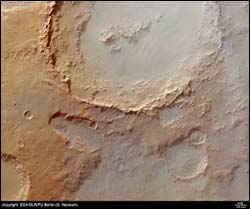Crater Hale in Argyre basin

Crater Hale in Argyre basin
These images, taken by the High Resolution Stereo Camera (HRSC) on board ESA’s Mars Express spacecraft, show Crater Hale in the Argyre basin of the southern hemisphere of Mars.
The images show an area close to the northern rim of the Argyre basin, located at latitude 36° South and longitude 324° East. The image was taken with a ground resolution of about 40 metres per pixel during Mars Express orbit 533 in June 2004.
Slight periodic colour and brightness variations in parts of the image indicate atmospheric waves in clouds.
Crater Hale, with its terraced walls, central peak and a part of the inner ring is visible in the upper (eastern) part of the image. The region has been eroded heavily by deposits caused by this impact, and subsequent processes.
On the southern rim of Hale, parts of the crater wall have moved downslope towards the crater’s centre (see black and white detailed image left).
At the bottom (western) part of the picture, as seen below in the other detailed image with high resolution, the surface shows a network of fluvial channels which may have been caused by running water.
The HRSC experiment on ESA’s Mars Express mission is led by the Principal Investigator Prof. Dr Gerhard Neukum, of the Freie Universitaet Berlin, who also designed the camera. The science team for the experiment consists of 45 Co-Investigators from 32 institutions and 10 nations.
The camera was developed at the German Aerospace Center (DLR) and built in co-operation with industrial partners EADS Astrium, Lewicki Microelectronic GmbH and Jena-Optronik GmbH.
The HRSC is operated by the DLR Institute of Planetary Research, through ESA’s European Space Operations Centre in Darmstadt, Germany.
Image resolution has been decreased for use on the internet. The colour images were processed using the HRSC nadir (vertical view) and three colour channels. The perspective views were calculated from the digital terrain model derived from the stereo channels. The 3D anaglyph image was created from the nadir channel and one of the stereo channels. Stereoscopic glasses are needed to view the 3D image.
For more information on Mars Express HRSC images, you might like to read our updated ’Frequently Asked Questions’.
Media Contact
All latest news from the category: Physics and Astronomy
This area deals with the fundamental laws and building blocks of nature and how they interact, the properties and the behavior of matter, and research into space and time and their structures.
innovations-report provides in-depth reports and articles on subjects such as astrophysics, laser technologies, nuclear, quantum, particle and solid-state physics, nanotechnologies, planetary research and findings (Mars, Venus) and developments related to the Hubble Telescope.
Newest articles

Properties of new materials for microchips
… can now be measured well. Reseachers of Delft University of Technology demonstrated measuring performance properties of ultrathin silicon membranes. Making ever smaller and more powerful chips requires new ultrathin…

Floating solar’s potential
… to support sustainable development by addressing climate, water, and energy goals holistically. A new study published this week in Nature Energy raises the potential for floating solar photovoltaics (FPV)…

Skyrmions move at record speeds
… a step towards the computing of the future. An international research team led by scientists from the CNRS1 has discovered that the magnetic nanobubbles2 known as skyrmions can be…





















